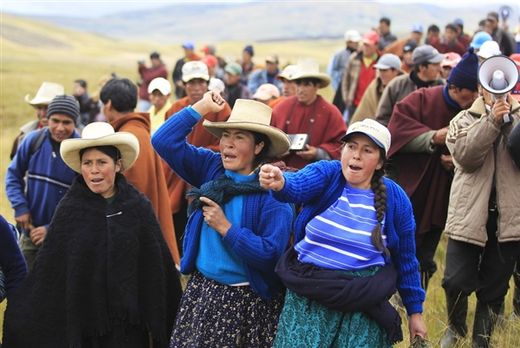
More brains between them than all Western government officials put together
Genetically modified foods are foods made from genetically modified organisms. A few weeks ago, California voters turned down Proposition 37, which would have required that GMO foods be labeled as such. Chemical companies and processed-food manufacturers heavily - and successfully - backed a campaign opposing the proposition. Nationwide, GMO crops are prevalent and efforts to label GMO foods have yet to get off the ground.
But outside the U.S., you can find a different approach.
Peru has said "no" to genetically modified foods - a 10-year ban on GMO foods takes effect this week. Peru's
ban on GMO foods prohibits the import, production and use of genetically modified foods. The law is aimed at safeguarding the country's agricultural diversity and preventing cross-pollination with non-GMO crops. It will also help protect Peruvian exports of organic products.
Peru isn't the first country to ban GMO foods or place restrictions on their use. Earlier this year,
Russia suspended imports of Monsanto's GMO corn after a French study linked the corn to cancer; France also has a
temporary ban on the corn. Ireland has
banned the growing of GMO crops since 2009. Japan and Egypt also ban the cultivation of GMO crops. In 2010, Switzerland
extended a moratorium on genetically modified animals and plants, banning GMOs until 2013.
Even countries that don't ban GMO crops may place restrictions on them. Germany requires farmers growing GMO crops to maintain a minimum distance from conventional farms and holds them liable for damages if conventional crops are contaminated via cross-pollination.
A German court upheld the restrictions, turning down a complaint that claimed the regulations unfairly damaged farmers.
In some places where GMOs are permitted,
labeling is required, enabling consumers to decide if they wish to purchase foods containing GMOs. In 1998, the European Union began requiring labels for food products with more than 0.9 percent of ingredients from genetically modified processes. Other countries, including Japan, Australia, New Zealand, China, Saudi Arabia, Thailand, India, Chile and South Africa, require labeling for foods containing GMOs.
The U.S., however, has no such requirements. Efforts to ban GMO foods or require labeling have occurred only on a local level. Most recently,
California's Proposition 37 was an attempt to require labeling of food containing genetically modified ingredients. The proposition was defeated at the ballot box after Monsanto and other companies poured money into opposing the effort, including
an ad campaign that claimed the labeling requirement would cause the cost of groceries to skyrocket.
When other countries are taking the step to ban GMO crops outright, the U.S. remains resistant to even allowing consumers to know if they are consuming food made with genetically modified ingredients. America is embracing the cultivation of GMO crops while other countries are taking a more cautious approach - and now
thousands of products in the United States contain GMOs, a contrast to Europe, where labeling is required and few products use genetically modified ingredients. Manufacturers of GMOs claim genetically engineered products are safe and well accepted, but the resistance to labeling suggest otherwise. When it comes to consumer choice on GMOs, the U.S. shouldn't be lagging behind.
Reader Comments
to our Newsletter